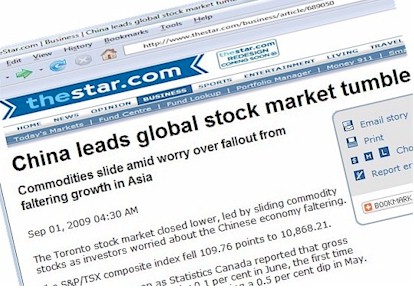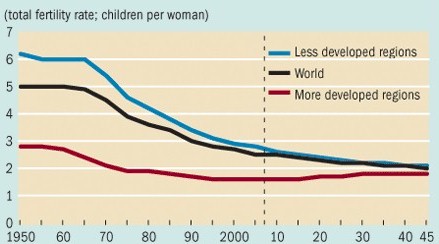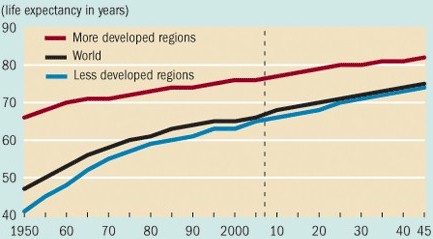Environment

| the
Economic
Environment |
 |
| INTRODUCTION | "Understanding
the economic environments of foreign countries and markets can help managers
predict how trends and events in those environments might effect their
companies' future performance there." Daniels
The purpose of discussing the Economic Environment is to give the student an understanding of some of the ways you can understand changes in the environment and how these changes influence your decisions - ie. the dollar going up or down effects how much you can afford to import a component part from a particular country. A part of the economic environment
is the changes in the value of a country's currency. We have a special
unit on the Canadian dollar exchange rate at
|
 |
The domestic economic environment
in each country is highly integrated with, and influenced by the economic
environment in other countries.
Example: China's stock market drops - Canada's TSX drops. It was explained in The Star (Sept 1st, 2009) that the Toronto stock market dropped due to declining commodity prices, which is a big part of our exports to China. |
| Why have the manufacturers in China reduced imports of commodities? - because they are reducing their exports to Europe and North America as a consequence of declining consumer demand - for example WalMart USA has less people buying "stuff" because so many Americans have lost their jobs and have less income. |
GDP/GNP - Gross Domestic
Product / Gross National Product
GNP/capita - a useful, or
not useful measurement -
"The World Bank uses GNP/capita
as a basis for its lending policies"
The purpose of economic analysis
-
"The purpose of economic
analysis is first to appraise the overall outlook of the economy and then
assess the impact of economic changes on the firm"
| economic analysis in a management context | The purpose,
or reason, for developing an economic analysis of a region or specific
country, is directly related to the ability to subsequently make managements
decisions about whether to do, or not do certain business things in that
country or with that country.
So when you are gathering
information, according to the headings on the list below, it is important
to keep in mind that you don't just collect any information, you collect
information which is useful in the context of allowing you to make a decision
- otherwise it is useless information and simply costs you time and money.
|
Terms used to describe economic circumstances for measuring business potential
| economic analysis in a management context | When you gather
information, according to the above headings, keep in mind, the
"So what" factor,* meaning So what if 71% of the people
have cell phones,
* attributed to Prof. Michael Jalland, Rotman (as recalled by Prof. James Davidson of Seneca College) |
| economic
indicators Income
|
|
| economic
indicators GOLD Q2 2015 |
WTGR |
| economic
indicators GOLD Q1 2010 |
"Canada is one of the world's top gold producers. There are lots of mining companies in Canada; the major mining companies include Placer Dome, Barrick, TVX Newmont Americas (TVXNA), Miramar Mining, Kinross Gold, Newmont and Cambior." http://www.goldpriceoz.com/gold-price-canada/ |
| economic
indicators GOLD 2007 |
..
|
| economic
indicators GOLD's perceived value |
It used to be
said that when people are fearful, either from threat of war or natural
disasters, the price of gold goes up as people loss confidence in the structures
of our civilization such as banks, and want to have their wealth in a more
tangible form that is
portable - meaning they can carry it with them if they are a refugee to another country, and convertable - meaning they can use it to buy something if the currency of their own country no longer has value. Portability and covertability have become important for many regions of the world in the early years of the new millenium where there is civil war, nature disasters such as eathquakes and tidal waves and weather extremes such as hurricanes. WTGR |
| economic
indicators Birth
|

source: U.N. World Population Prospects 2004 as quoted in "Booms, Busts, and Echoes" by David E. Bloom and David Canning on the IMF website www.imf.org/external/pubs/ft/fandd/2006/09/bloom.htm |
| economic
indicators Birth
|
"The developing
world has seen significant reductions in infant and child mortality over
the past 50 years. These gains are primarily the result of improved nutrition,
public health interventions related to water and sanitation, and medical
advances, such as the use of vaccines and antibiotics."
Bloom and Canning Consequences of birth rates being higher in less developed regions
|
| economic
indicators Birth
|

source: U.N. World Population Prospects 2004 as quoted in "Booms, Busts, and Echoes" by David E. Bloom and David Canning on the IMF website www.imf.org/external/pubs/ft/fandd/2006/09/bloom.htm consequences
|
| economic
indicators:
education
|
Why do you want
poorer countries to have a higher level of literacy?
Isn't it better to have a "supply" of uneducated people for cheap labour intensive tasks? There are over 860 million illiterate people in the world, of whom:
source: www.globaleducation.edna.edu.au/globaled/go/pid/27
China * but, according to UNESCO stats for 2007 leads the world now in the absolute number of university graduates see http://stats.uis.unesco.org/unesco/TableViewer/document.aspx?ReportId=143&IF_Language=eng |
| economic
indicators:
The TRADE SUPLUS |
For a country
like Canada, that depends so heavily on people buying products we export
- products made from our resources, it has been the case for decades that
we have an international balance of trade surplus - meaning simply we export
more stuff than we import.
What matters to economists, and the people who watch our currency exchange rate changes with other countries, is how the trade surplus continues - meaning does it grow slightly, or contract. You might think it is a good thing if the trade surplus grows, but one of the concerns is that this may cause inflation Journalist Greg Quinn of
the Bloomberh News was quoted in June 2007 saying
Quinn says "The Bank of Canada may raise interest rates as soon as July, after government reports showed a wider trade surplus, a fourth month of 33-year-low unemployment, and higher-than-expected home starts." At the same time the trade surplus is developing larger, you have a situation in Canada in June 2007 where the dollar is reaching a high ratio to the U.S. dollar making it possible for Canadian exporters to receive more money from their exports, at the same time that it is cheaper for importers to bring things in to Canada. WTGR |
.
|
|
CONTACT I MAIN PAGE I NEWS GALLERY I E-BIZ SHORTCUTS I INT'L BIZ SHORTCUTS I MKTG&BUSINESS SHORTCUTS I TEACHING SCHEDULE |
| . | |
| MISTAKES ITEXTS USED I IMAGES I RANK IDISCLAIMER I STUDENT CONTRIBUTORS I FORMER STUDENTS I | |
| . |